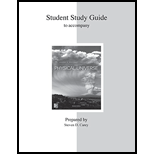
The correct option from given set of options.
Answer to Problem 1MC
The correct option is “c. compounds with complex molecules”
Explanation of Solution
All matter in the universe is made up of atoms.
Conclusion:
From the above explanation, we find that option c would be the best option among the given set of options.
The compound produced by plants and animals includes carbonates and carbon oxides. But Organic chemistry is thought to deal only with carbon compounds. This was also disproved. Hence, option a is an incorrect option.
Organic chemistry is thought to deal only with carbon compounds. This was also disproved. Hence, option b is an incorrect option.
Organic chemistry doesn’t deal alone with the determination of structural formulas. Hence, option d is an incorrect option.
Want to see more full solutions like this?
Chapter 13 Solutions
Study Guide For The Physical Universe
- The polyester formed from lactic acid (shown below) is used for tissue implants and surgical sutures that will dissolve in the body. Draw the structure of a portion of this polymer.arrow_forwardShow the Kekul representation and the preferred representation of benzenes structural formula.arrow_forwardUse both full and condensed structural formulas to show the difference between methane and a methyl group and between ethane and an ethyl group.arrow_forward
- Draw the Lewis structure for formaldehyde, H2CO, a compound whose odor is known to most biology students because of its use as a preservative. Show a structure with dots only, and then show one with both dots and dashes.arrow_forwardWhat two simpler sugars combine to form sucrose? Which sugar is the monomer of both starch and cellulose?arrow_forwardBoth ethene and ethyne are often called by their more common names. Give the common names and draw the structural formula for each compound.arrow_forward
- Name the compound represented by a hexagon and give its molecular formula and full structural formula.arrow_forwardClassify each of the following hydrocarbon structural formulas as an alkane, cycloalkane, alkene, alkyne, or aromatic hydrocarbon. (a) (b) CH3CH2 CH2CH2CH3 (c) (d) HCCCH2CH3 (e)arrow_forwardWhich of these structural formulas is valid, and which is incorrect? (a) (b)arrow_forward
 An Introduction to Physical SciencePhysicsISBN:9781305079137Author:James Shipman, Jerry D. Wilson, Charles A. Higgins, Omar TorresPublisher:Cengage Learning
An Introduction to Physical SciencePhysicsISBN:9781305079137Author:James Shipman, Jerry D. Wilson, Charles A. Higgins, Omar TorresPublisher:Cengage Learning
